英美报刊阅读教程中级精选本 第五版 端木义万lesson 5 Food and Obesity
- 格式:doc
- 大小:34.00 KB
- 文档页数:3
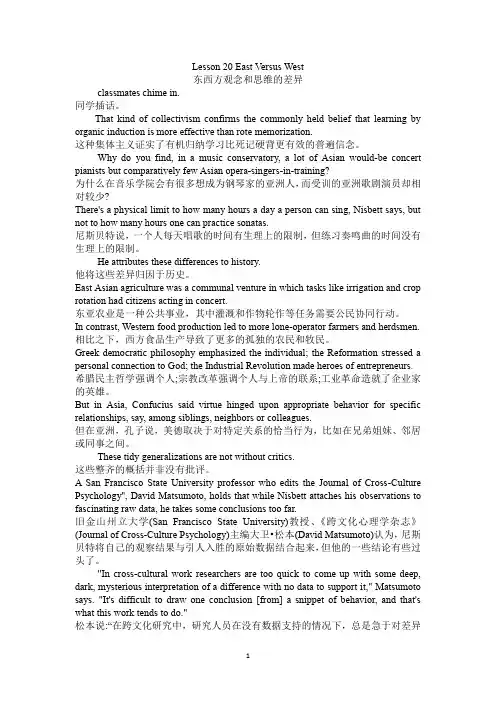
Lesson 20 East Versus West东西方观念和思维的差异classmates chime in.同学插话。
That kind of collectivism confirms the commonly held belief that learning by organic induction is more effective than rote memorization.这种集体主义证实了有机归纳学习比死记硬背更有效的普遍信念。
Why do you find, in a music conservatory, a lot of Asian would-be concert pianists but comparatively few Asian opera-singers-in-training?为什么在音乐学院会有很多想成为钢琴家的亚洲人,而受训的亚洲歌剧演员却相对较少?There's a physical limit to how many hours a day a person can sing, Nisbett says, but not to how many hours one can practice sonatas.尼斯贝特说,一个人每天唱歌的时间有生理上的限制,但练习奏鸣曲的时间没有生理上的限制。
He attributes these differences to history.他将这些差异归因于历史。
East Asian agriculture was a communal venture in which tasks like irrigation and crop rotation had citizens acting in concert.东亚农业是一种公共事业,其中灌溉和作物轮作等任务需要公民协同行动。
In contrast, Western food production led to more lone-operator farmers and herdsmen. 相比之下,西方食品生产导致了更多的孤独的农民和牧民。
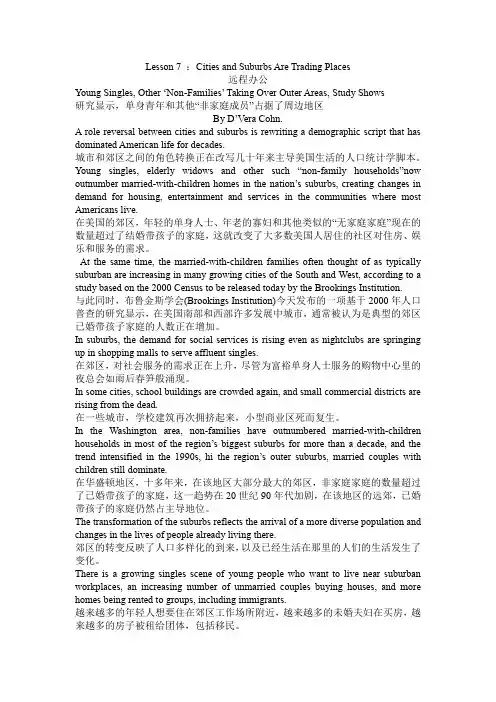
Lesson 7 :Cities and Suburbs Are Trading Places远程办公Young Singles, Other ‘Non-Families’ Taking Over Outer Areas, Study Shows研究显示,单身青年和其他“非家庭成员”占据了周边地区By D’Vera Cohn.A role reversal between cities and suburbs is rewriting a demographic script that has dominated American life for decades.城市和郊区之间的角色转换正在改写几十年来主导美国生活的人口统计学脚本。
Young singles, elderly widows and other such “non-family households”now outnumber married-with-children homes in the nation’s suburbs, creating changes in demand for housing, entertainment and services in the communities where most Americans live.在美国的郊区,年轻的单身人士、年老的寡妇和其他类似的“无家庭家庭”现在的数量超过了结婚带孩子的家庭,这就改变了大多数美国人居住的社区对住房、娱乐和服务的需求。
At the same time, the married-with-children families often thought of as typically suburban are increasing in many growing cities of the South and West, according to a study based on the 2000 Census to be released today by the Brookings Institution.与此同时,布鲁金斯学会(Brookings Institution)今天发布的一项基于2000年人口普查的研究显示,在美国南部和西部许多发展中城市,通常被认为是典型的郊区已婚带孩子家庭的人数正在增加。
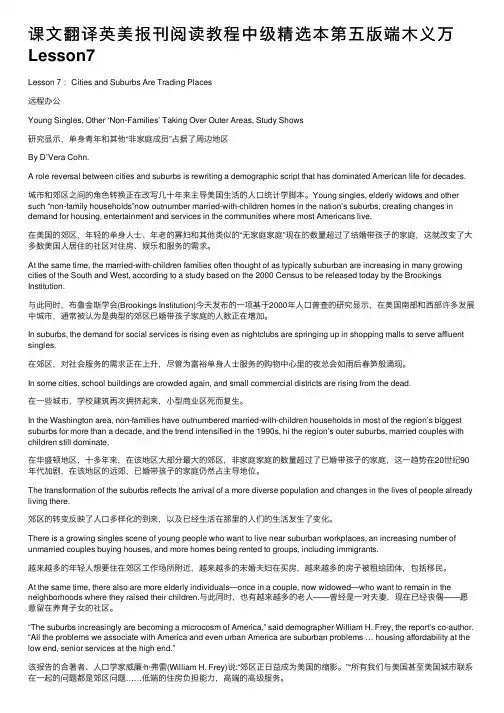
课⽂翻译英美报刊阅读教程中级精选本第五版端⽊义万Lesson7Lesson 7 :Cities and Suburbs Are Trading Places远程办公Young Singles, Other ‘Non-Families’ Taking Over Outer Areas, Study Shows研究显⽰,单⾝青年和其他“⾮家庭成员”占据了周边地区By D’Vera Cohn.A role reversal between cities and suburbs is rewriting a demographic script that has dominated American life for decades.城市和郊区之间的⾓⾊转换正在改写⼏⼗年来主导美国⽣活的⼈⼝统计学脚本。
Young singles, elderly widows and other such “non-family households”now outnumber married-with-children homes in the nation’s suburbs, creating changes in demand for housing, entertainment and services in the communities where most Americans live.在美国的郊区,年轻的单⾝⼈⼠、年⽼的寡妇和其他类似的“⽆家庭家庭”现在的数量超过了结婚带孩⼦的家庭,这就改变了⼤多数美国⼈居住的社区对住房、娱乐和服务的需求。
At the same time, the married-with-children families often thought of as typically suburban are increasing in many growing cities of the South and West, according to a study based on the 2000 Census to be released today by the Brookings Institution.与此同时,布鲁⾦斯学会(Brookings Institution)今天发布的⼀项基于2000年⼈⼝普查的研究显⽰,在美国南部和西部许多发展中城市,通常被认为是典型的郊区已婚带孩⼦家庭的⼈数正在增加。

Lesson5 Food and ObesityBeing fat is be coming the norm for Americans.As it will soon be come in this country, I have seen the future, and it's extra large.By Joan SmithA friend who happens to be both American and a superb cook-his poulet de Bresse en deuil is one of the most memorable dishes I have tasted--called me a couple of days ago,enthusing about a lecture he had just at ended.The thesis,he said,was that the human body has changed irrevocably over the last quarter of a century and that the physical environment—chairs,beds, airline seats-will gradually adapt to accommodate the new shape.It is,of course,in the US, where my friend no longer lives,that this evolutionary experiment is most advanced;for years now, millions of people have been gorging themselves on vast helpings of fast food, with the consequence that about 60 percent of the population is overweight.According to Greg Critser, author of Fat Land:How Americans Became the Fattest People in the Word, none of this has happened by accident. Critser argues that the challenge to the US food industry in the 1970s was that the population was growing more slowly than the food supply, so people had to be persuaded to change their eating habits. Fast food, invented after the Second World War as an affordable way of getting families to eat together, became a means of selling surplus fat and sugar to the far-from-unwilling masses. This is a social revolution on a grand scale as scarcity, with which most human beings have had to struggle throughout history, has given way to an apparently permanent state of plenty.It may also help to explain why the magician David Blaine, suspended without food in a Perspex box beside Tower Bridge,has such a grip on people's imaginations.In an astonishingly short period of time, starvation has metamorphosed from a threat to a spectacle, and families are turning out en mass eat weekends to see how his hunger strike is going. For the fifth of the British population who are obese, and unused to doing without food for more than a few hours, the notion of someone giving it up for 44 days is unthinkable, some normal-size people have turned up to mock, throwing egg, cooking food and even trying to cut off the water supply to the hung American. Perhaps this is the point, that there are so few starving Americans in the world, which makes his self-imposed ordeal appear ludicrously self-indulgent.Yet it is possible to take Critser’s argument a stage further and suggest that millions of Americans are trapped between two industries, fast food and slimming, which enjoy a cosily symbiotic relationship. Research by a fast-food chain showed that what customers cared about was neither taster nor quality but portion size; what they have come to expect from food, and what their neighbours are beginning to want as well-obesity has increased by 158 per cent in Mexico in a decade, since fast food outlets began to replace the traditional diet-is a feeling of being stuffed to the gills. Cooking has become a spectator sport, something to watch famous people do on telly, as the populations of affluent countries rely increasingly on supermarket meals and takeaways. For many people, eating has become an addiction rather than a pleasure, and going on a diet merely replaces on morbid habit with another.In the circumstances, it is not really surprising that people are confused andangered by Blaine, whose stunt highlights the disordered relation to eating which has become habitual in Western societies. Far from being an object of derision as his body enters ketosis, the state in which it starts to consume itself, he should logically be the envy of all those individuals who are endlessly trying Atking and other fashionable diets. We are so used to hearing people pay to get hungry, turning the condition of starving Africans into a longed-for luxury. There is something shaming about this, and about the extent to which so many people-like Kafka’s hunger artist, who was addicted to starving-have lost control of their appetites.Perhaps the thesis my friend described to me on the phone is correct, and houses and cars and planes will just have to get bigger as the human race-the affluent part of it, that is-continues to inflate itself with empty calories. Bizarrely, being fat is fast becoming the norm for Americans, and even in this country it will soon be people like me(5ft 5in and a paltry nine stone) who are the freaks. I have seen the future, and it’s extra large.Plain food moves up a classI was supposed to give a talk myself at the weekend, on food and class, but had to pull out because of an annoyingly persistent throat virus. I was going to discuss “ eating above your station”, which is something I learnt to do, like many people of my generation, when I went to university. Until then, I had scarcely ever eaten in a restaurant and I had never tried what my family referred to as “foreign muck”. Ever macaroni cheese was too exotic for my parents, who tipped it into the bin when I came home from cookery class with a Pyrex dish full of overcooked pasta and melted cheddar.Food was plain, served on a plate with thick portions of gravy or custard, and the idea of helping yourself from serving dishes seemed the height of sophistication. What strikes me now, looking back on that traditional working-class diet, is that it was unadventurous but it didn’t do me ant harm. My father grew vegetables, my mother shelled peas and sliced carrots, and I don’t recall anyone in my family being overweight. It’s hard to eat too much when someone else puts the food on your plate. These days, if a working-class diet can be said to exist, it is surperficially much more cosmopolitan-curries, pizza, the ubiquitous Chinese takeaway-but adapted to satisfy the British appetite for saturated fat, salt and sugar.In a curious reversal, plain food-simple grilled fish with a green salad, such as the wonderful meal I ate in Marbella in the summer-has become the province of the middle class. I am one of those lucky people who changed class at the right time and in the right direction, but the effects of our eating habits-a slender elite, as millions of ordinary people pile on the pounds-suggest that class divisions are as deep as ever.Bring on the euroI was driving back from a health farm the other day when the friend with whom I had just shared three days of massage, facials and Pilates said rather nervously that she wanted to ask me a question. I naturally assumed that she wanted to talk about men, underwear or the least painful way of shaving your legs, as women do when they know each other well, but it turned out to be something far more intimate. Am I, she asked, in favour of joining the euro?Oh God, anything but that. Admitting that you fell no attachment to the pound, and would like to use the euro in Waitrose, is like telling your friends that you have joined a weird sect. I don’t think people spend much time thinking about Gordon Brown’s five economic tests, but there is a presumption that the British did jolly week to stay out of the eurozone when all those foreigners gave up their currencies almost two years ago. And now we’re supposed to admire the Swedes for resoundingly voting “No” at the weekend.I don’t think I’ve ever confessed this in public before, and I suspect I won’t be invited to any smart parties for weeks at the very least. But I really want to join the euro. And since we both came out somewhere on the M1-it was a relief, I can tell you-I now know at least one other person who feels the same.。
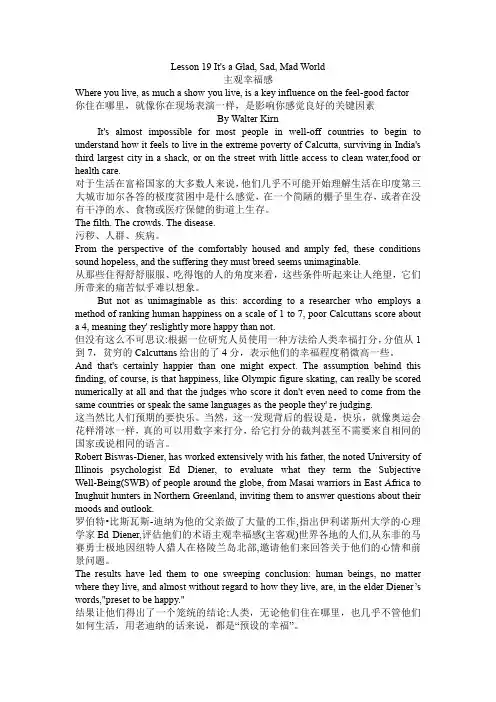
Lesson 19 It's a Glad, Sad, Mad World主观幸福感Where you live, as much a show you live, is a key influence on the feel-good factor你住在哪里,就像你在现场表演一样,是影响你感觉良好的关键因素By Walter KirnIt's almost impossible for most people in well-off countries to begin to understand how it feels to live in the extreme poverty of Calcutta, surviving in India's third largest city in a shack, or on the street with little access to clean water,food or health care.对于生活在富裕国家的大多数人来说,他们几乎不可能开始理解生活在印度第三大城市加尔各答的极度贫困中是什么感觉,在一个简陋的棚子里生存,或者在没有干净的水、食物或医疗保健的街道上生存。
The filth. The crowds. The disease.污秽、人群、疾病。
From the perspective of the comfortably housed and amply fed, these conditions sound hopeless, and the suffering they must breed seems unimaginable.从那些住得舒舒服服、吃得饱的人的角度来看,这些条件听起来让人绝望,它们所带来的痛苦似乎难以想象。
But not as unimaginable as this: according to a researcher who employs a method of ranking human happiness on a scale of 1 to 7, poor Calcuttans score about a 4, meaning they' reslightly more happy than not.但没有这么不可思议:根据一位研究人员使用一种方法给人类幸福打分,分值从1到7,贫穷的Calcuttans给出的了4分,表示他们的幸福程度稍微高一些。
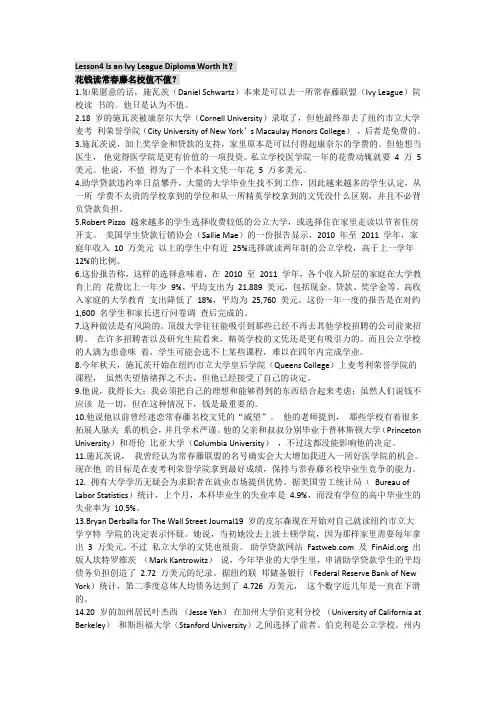
Lesson4 Is an Ivy League Diploma Worth It?花钱读常春藤名校值不值?1.如果愿意的话,施瓦茨(Daniel Schwartz)本来是可以去一所常春藤联盟(Ivy League)院校读书的。
他只是认为不值。
2.18 岁的施瓦茨被康奈尔大学(Cornell University)录取了,但他最终却去了纽约市立大学麦考利荣誉学院(City University of New York’s Macaulay Honors College),后者是免费的。
3.施瓦茨说,加上奖学金和贷款的支持,家里原本是可以付得起康奈尔的学费的。
但他想当医生,他觉得医学院是更有价值的一项投资。
私立学校医学院一年的花费动辄就要4 万5 美元。
他说,不值得为了一个本科文凭一年花5 万多美元。
4.助学贷款违约率日益攀升,大量的大学毕业生找不到工作,因此越来越多的学生认定,从一所学费不太贵的学校拿到的学位和从一所精英学校拿到的文凭没什么区别,并且不必背负贷款负担。
5.Robert Pizzo 越来越多的学生选择收费较低的公立大学,或选择住在家里走读以节省住房开支。
美国学生贷款行销协会(Sallie Mae)的一份报告显示,2010 年至2011 学年,家庭年收入10 万美元以上的学生中有近25%选择就读两年制的公立学校,高于上一学年12%的比例。
6.这份报告称,这样的选择意味着,在2010 至2011 学年,各个收入阶层的家庭在大学教育上的花费比上一年少9%,平均支出为21,889 美元,包括现金、贷款、奖学金等。
高收入家庭的大学教育支出降低了18%,平均为25,760 美元。
这份一年一度的报告是在对约1,600 名学生和家长进行问卷调查后完成的。
7.这种做法是有风险的。
顶级大学往往能吸引到那些已经不再去其他学校招聘的公司前来招聘。
在许多招聘者以及研究生院看来,精英学校的文凭还是更有吸引力的。

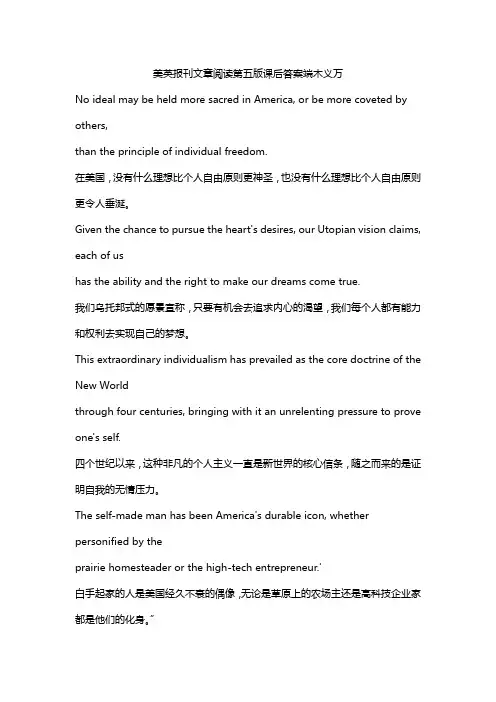
美英报刊文章阅读第五版课后答案端木义万No ideal may be held more sacred in America, or be more coveted by others,than the principle of individual freedom.在美国,没有什么理想比个人自由原则更神圣,也没有什么理想比个人自由原则更令人垂涎。
Given the chance to pursue the heart's desires, our Utopian vision claims, each of ushas the ability and the right to make our dreams come true.我们乌托邦式的愿景宣称,只要有机会去追求内心的渴望,我们每个人都有能力和权利去实现自己的梦想。
This extraordinary individualism has prevailed as the core doctrine of the New Worldthrough four centuries, bringing with it an unrelenting pressure to prove one's self.四个世纪以来,这种非凡的个人主义一直是新世界的核心信条,随之而来的是证明自我的无情压力。
The self-made man has been America's durable icon, whether personified by theprairie homesteader or the high-tech entrepreneur.'白手起家的人是美国经久不衰的偶像,无论是草原上的农场主还是高科技企业家都是他们的化身。
”Yet, from the beginning,the idea of a community of rugged individualists struckmany as an oxymoron. In the 1830s, Alexis de Tocqueville warned that the tendencyof Americans to do their own thing could very likely doom the country. 然而,从一开始,由粗犷的个人主义者组成的社会这个想法就给许多人以矛盾的感觉。
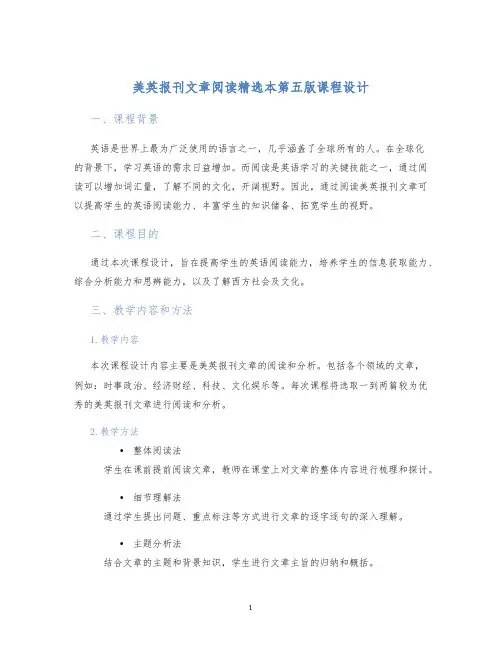
美英报刊文章阅读精选本第五版课程设计一、课程背景英语是世界上最为广泛使用的语言之一,几乎涵盖了全球所有的人。
在全球化的背景下,学习英语的需求日益增加。
而阅读是英语学习的关键技能之一,通过阅读可以增加词汇量,了解不同的文化,开阔视野。
因此,通过阅读美英报刊文章可以提高学生的英语阅读能力、丰富学生的知识储备、拓宽学生的视野。
二、课程目的通过本次课程设计,旨在提高学生的英语阅读能力,培养学生的信息获取能力、综合分析能力和思辨能力,以及了解西方社会及文化。
三、教学内容和方法1.教学内容本次课程设计内容主要是美英报刊文章的阅读和分析。
包括各个领域的文章,例如:时事政治、经济财经、科技、文化娱乐等。
每次课程将选取一到两篇较为优秀的美英报刊文章进行阅读和分析。
2.教学方法•整体阅读法学生在课前提前阅读文章,教师在课堂上对文章的整体内容进行梳理和探讨。
•细节理解法通过学生提出问题、重点标注等方式进行文章的逐字逐句的深入理解。
•主题分析法结合文章的主题和背景知识,学生进行文章主旨的归纳和概括。
•互动讨论法学生分组进行小组讨论,交流意见和看法,提高学生的思维能力和口头表达能力。
3.教学评价1.每次阅读任务后,要求学生按时完成作业,并在课堂上进行互相分享和讨论。
2.集中测试和期末考试。
集中测试主要针对课堂掌握的细节和理解能力,期末考试主要测试学生的综合阅读和分析能力。
3.课程评价将分为两个部分,即课堂表现和作业完成情况。
其中,课堂表现占40%,作业完成情况占60%。
四、教学重点和难点1.阅读技巧的习得,特别是针对语言和文化差异方面的问题。
2.对原文的理解和分析能力的提升,这需要学生具有一定的背景知识和较强的逻辑思维能力。
五、教学进度和安排1.第一周:课程介绍,学生选定报纸和杂志,规划课程,明确要求。
2.第二周到第十三周:每周选取一到两篇较为优秀的美英报刊文章进行阅读和分析。
3.第十四周:集中测试。
4.第十五周到第十六周:期末考试及课程总结。


美英报刊阅读教程中级第五版答案Thethree bigmilestonesforAmerica ‘spopulationarethefollowing: 1915whenAmerica ‘s populationgrewto100 million, 1967whenAmerica s populationincreased to200 million and 2006 when America ‘s population reached 300 million.America ‘srecentpopulationgrowthhasbeenextraordinary.Since2000alone,Americahasadded20million people.InsharpcontrastwithAmerica‘spopulationincrease, Europe‘s birth rates have been plunging and Japan‘s population has been shrinking.The fast growth of the South and the West has been buoyed by immigration, lower costs, and recreationalThe fast growth of the South and the West has been buoyed by immigration, lower costs, and recreational opportunities.The major factor in the population growth is immigration. Since 2000 alone, there has been a 16percent rise in the number of immigrants living in American households.The most striking difference is the change of the main source. Before 1967, the main source of immigrantswasWestern Europe. However, after President Johnson signed the Immigration and Naturalization Act in1965tostopracialandethnicquotas for newimmigrants, and once the Mexican economy tanked in the 1970s, immigrants from Mexico sharply increased. In Fort Wayne, nearly 80 percent of Hispanics are Mexican. An estimated 12 million undocumented immigrantsnow live in America.According tothearticle,the influx ofnewimmigrants hascaused the problem of racial tensions.Back in 1990, the median age in America was 22.9 years. But with people having fewer babies, that number started to climb. Lower fertility rates mean older populations. The baby boom causeda brief pause in this movement during the 1950s and 1960s, but the aging trend has since resumed.The median age is up to 36.5 and is expected to rise to 39 by 2030 before leveling off.People like Mayowillnbsp;graduallynbsp;adaptnbsp;tonbsp;accommodatenbsp;thenbsp;newnbsp;shape.Itnbsp;is,ofnbsp;course,innbsp;thenbsp;wherenbsp; mynbsp; friendnbsp; nonbsp; longernbsp; lives,thatnbsp; thisnbsp; evolutionarynbsp; experimentnbsp; isnbsp; mostnbsp; advanced;fornbsp; yearsnbsp; now,nbsp; millionsnbsp; ofnbsp; peoplenbsp; havenbsp; beennbsp; gorgingnbsp; themselvesnbsp;vastnbsp;helpingsnbsp;ofnbsp;fastnbsp;food,nbsp;withnbsp;thenbsp;consequencenbsp;thatnbsp;aboutnbsp;60nbsp;nbsp;percentnbsp;ofnbsp;thenbsp;populationnbsp;isnbsp;overweight. nbsp;Accordingnbsp;tonbsp;Gregnbsp;Critser,nbsp;authornbsp;ofnbsp;Fatnbsp;LandAmericansnbsp;Becamenbsp;thenbsp;Fattestnbsp;Peoplenbsp;innbsp;thenbsp;Word,nbsp;nonenbsp;ofnbs p;thisnbsp;hasnbsp;happenednbsp;bynbsp;accident.nbsp;Critsernbsp;ar guesnbsp;thatnbsp;thenbsp;challengenbsp;tonbsp;thenbsp;USnbsp;foodnbsp;industrynbsp;innbsp;thenbsp;1970snbsp;wasnbsp;thatnbsp;thenbsp;populationnbsp;wasnbsp;growingnbsp;morenbsp;slowlynbsp;thannbsp;thenbsp;foodnbsp;su pply,nbsp;sonbsp;peoplenbsp;hadnbsp;tonbsp;benbsp;persuadednbsp;t onbsp;changenbsp;theirnbsp;eatingnbsp;habits.nbsp;Fastnbsp;food,nbsp;inventednbsp; afternbsp;thenbsp;Secondnbsp;Worldnbsp;Warnbsp;asnbsp;annbsp;affo rdablenbsp;waynbsp;ofnbsp;gettingnbsp;familiesnbsp;tonbsp;eatnbsp;together,nbsp;becamenbsp;anbsp;meansnbsp;ofnbsp;sellingnbsp;surplusnbsp;fatnbsp;andnbsp;sugarnbsp;tonbsp;thenbsp;farfromunwillingnbsp;masses.nbsp;Thisnbsp;isnbsp;anbsp;socialnbsp;revolu tionnbsp;onnbsp;anbsp;grandnbsp;scalenbsp;asnbsp;scarcity,nbsp;withnbsp;whichnbsp;mostnbsp;humannbsp;beingsnbs p;havenbsp;hadnbsp;tonbsp;strugglenbsp;throughoutnbsp;history,nbsp; hasnbsp;givennbsp;waynbsp;tonbsp;annbsp;apparentlynbsp;permanentnbsp; statenbsp;ofnbsp;plenty.nbsp;Itnbsp;maynbsp;alsonbsp;helpnbsp;tonbsp;explainnbsp;whynbsp;th enbsp;magiciannbsp;Davidnbsp;Blaine,nbsp;suspendednbsp;withoutnbs p;foodnbsp;innbsp;anbsp;Perspexnbsp;boxnbsp;besidenbsp;Towernbsp;Bridge,hasnbsp;suchnbsp;anbsp;gripnbsp;onnbsp;people#39;snbsp;imaginations.Innbsp;annbsp;astonishinglynbsp;shortnbsp;periodnbs p;ofnbsp;time,nbsp;starvationnbsp;hasnbsp;metamorphosednbsp;fromnbsp;anbsp;threatnbsp;tonbsp;anbsp;spectacle,nbsp;andnbsp;f amiliesnbsp;arenbsp;turningnbsp;outnbsp;ennbsp;massnbsp;eatnbsp;we ekendsnbsp;tonbsp;seenbsp;hownbsp;hisnbsp;hungernbsp;strikenbsp;isnbsp;going.nbsp;Fornbs p;thenbsp;fifthnbsp;ofnbsp;thenbsp;Britishnbsp;populationnbsp;whonbs p;arenbsp;obese,nbsp;andnbsp;unusednbsp;tonbsp;doingnbsp;withoutnbsp;foodnbsp;for nbsp;morenbsp;thannbsp;anbsp;fewnbsp;hours,nbsp;thenbsp;notionnbs p;ofnbsp;someonenbsp;givingnbsp;itnbsp;upnbsp;fornbsp;44nbsp;daysnbsp;isnbsp;izenbsp; peoplenbsp;havenbsp;turnednbsp;upnbsp;tonbsp;mock,nbsp;throwingnbsp;egg,nbsp;cookingnbsp;foodnbsp;andnbsp ;evennbsp;tryingnbsp;tonbsp;cutnbsp;offnbsp;thenbsp;waternbsp;suppl ynbsp;tonbsp;thenbsp;hungnbsp;American.nbsp;Perhapsnbsp;thisnbsp;isnbsp;thenbsp;poi nt,nbsp;thatnbsp;therenbsp;arenbsp;sonbsp;fewnbsp;starvingnbsp;Amer icansnbsp;innbsp;thenbsp;world,nbsp;whichnbsp;makesnbsp;hisnbsp;self imposednbsp;ordealnbsp;appearnbsp;ludicrouslynbsp;self indulgent.nbsp;Yetnbsp;itnbsp;isnbsp;possiblenbsp;tonbsp;takenbsp;Critser’snbsp;argumentnbsp;anbsp;stagenbsp;furthernbsp;andnbsp;suggestnbsp;thatnbsp;millionsnbsp;ofnbsp;Americansnbsp;arenbsp;trappednbsp;betweennbsp;twonbsp;industries,nbsp;fastnbsp;foodnbsp;andnbsp;slimming,nbsp;whichnbsp;enjoynbsp;anbsp;cosilynbsp;symbioticnbsp;relationship.nbsp;Researchnbsp;bynbsp;anbsp;fastfoodnbsp;chainnbsp;showednbsp;thatnbsp;whatnbsp;customersnbsp;carednbsp;aboutnbsp;wasnbsp;neithernbsp;tasternbsp;nornbsp;qualitynbsp;butnbsp;portionnbsp;size;n bsp;whatnbsp;theynbsp;havenbsp;comenbsp;tonbsp;expectnbsp;fromnbsp;food,n bsp;andnbsp;whatnbsp;theirnbsp;neighboursnbsp;arenbsp;beginningnb sp;tonbsp;wantnbsp;asnbsp;wellobesitynbsp;hasnbsp;increasednbsp;bynbsp;158nbsp;pernbsp;centn bsp;innbsp;Mexiconbsp;innbsp;anbsp;decade,nbsp;sincenbsp;fastnbsp;f oodnbsp;outletsnbsp;begannbsp;tonbsp;replacenbsp;thenbsp;traditionalnbsp ;dietisnbsp;anbsp;feelingnbsp;ofnbsp;beingnbsp;stuffednbsp;tonbsp;the nbsp;gills.nbsp;Cookingnbsp;hasnbsp;becomenbsp;anbsp;spectatornbsp;sport,nb。
Lesson 8 Seeing the Back of the Car汽车文化“I’LL love and protect this car until death do us part,” says Toad, a 17-year-old loser whose life is briefly transformed by a “super fine” 1958 Chevy Impala in “American Graffiti”.一名17岁的失败者,图德说,“我将会爱护这辆车并且保护它,一直到死亡把我们分开为止”,他的生活由于“美国风情画”中的一辆1958年的超精细雪佛兰羚羊而完全改变了。
The film follows him, his friends and their vehicles through a late summer night in early 1960s California: cruising the main drag, racing on the back streets and necking in back seats of machines which embody not just speed, prosperity and freedom but also adulthood, status and sex.这部电影带着他,他的朋友们和他们的车穿越到了二十世纪六十年代加州,一个夏天的夜晚:快而平衡地穿过那里的主要街道,在破旧的街巷中飙车,在汽车后座位上拥吻,这辆车体现的不仅仅是速度,财富和自由,还有成年的宣告,社会地位和性关系的成熟。
The movie was set in an age when owning wheels was a norm deeply desired and newly achievable.当时这部电影的制作背景是----拥有辆车的深深渴望和它代表的一种新型的成就。
英美报刊阅读教程中级精选本第五版端木义万Lesson19ItsaGlad,Sad,MadWorldLesson 19 It's a Glad, Sad, Mad WorldWhere you live, as much a show you live, is a key influence on the feel-good factor1By Walter Kirn1.It' s almost impossible for most people in well-off countries to begin to understand how it feels to live in the extreme poverty of Calcutta2, surviving in India's third largest city in a shack, or on the street with little access to clean water,food or health care. The filth. The crowds. The disease. From the perspective of the comfortably housed and amply fed, these conditions sound hopeless, and the suffering they must breed seems unimaginable.2.But not as unimaginable as this: according to a researcher who employs a method of ranking human happiness on a scale of 1 to 7, poor Calcuttans score about a 4, meaning they' reslightly more happy than not. And that' s certainly happier than one might expect. The assumption behind this finding, of course, is that happiness, like Olympic figure skating, can really be scored numerically at all and that the judges who score it don' t even need to come from the same countries or speak the same languages as the people they' re judging.3.Robert Biswas-Diener, has worked extensively with his father, the noted University of Illinois psychologist Ed Diener, to evaluate what they term the Subjective Well-Being(SWB)3 of people around the globe, from Masai warriors in East Africa to Inughuit hunters in Northern Greenland, inviting them to answer questions about their moods and outlook. The results have led them to one sweeping conclusion: human beings, no matterwhere they live, and almost without regard to how they live, are, in the elder Diener' s words,"preset to be happy."44.He thinks of this predilection as a "gift" bestowed on people by evolution that helpsus adapt and flourish even in fairly trying circumstances.5 But there are other theories. Maybe, he says, we're "socialized" to be happy, "in order to facilitate smooth social functioning."6Whatever the reasons for this gift, however, its benefits don' t seem to beevenly distributed around the globe./doc/7f6202157.html,tin Americans, for example, are among the happiest people in the world, according to study after study. A survey of college students in the mid-1990s compared so-called national differences in positivity and ranked Puerto Rico, Colombia and Spainas the three most cheerful locales. This may surprise those who equate happiness with flat-screen TVs and ice-cube-dispensing refrigerator doors. But not to Ed Diener. For him, the high spirits of the relatively poor Puerto Ricans and Colombians stem from a "positivity tendency" that"may be rooted in cultural norms regarding the value of believing in aspects of life in general to be good." 7 Translation: Latin Americans are happier because they look on the sunny side of life.6.That tendency does not seem to be popular in East Asia. Among the bottom five in the study are Japan, China and South Korea, the outliers of unhappiness. "We have found that East Asians tend to weight the worst areas of their lives when computing their life satisfaction8," Diener reports.7.That may be a reflection of a difference in cultural expectation, says Shinobu Kitayama, a professor of psychology at the University of Michigan, who does research on the connection between culture and well-being. "While Americans seehappiness as a goal. Self-esteern is very important to them. But Asians, from the beginning of life,are trained to focus on the negative aspects of themselves." That extends to Asians' view of happiness itself, which Kitayama sees as surprisingly dialectic. He recently asked American and Japanese college students to describe the positive and negative aspects of happiness. The American students could only see happiness as a pure good, while the Japanese students repeatedly pointed out the potential drawbacks to happiness—the way personal success, for instance, could invite envy. That might be part of the fun for your average American freshman, but Asians often see little value in personal happiness that upsets family or group harmony. "Asian happiness is much more social than personal," says Kitayama. When asked to estimate their happiness in surveys, Asians might naturally underrate themselves for that reason, and it's not clear whether the yactually feel unhappy or whether they are just moderating their responses.9Ultimately personal happiness may simply not be what many Asians are searching for.8.But that may be changing.Over the past 50 years, Asia has undergone a wrenching crash course in economic and political modernization.10 A wealth of new possibilities are now available to Asians across the region, yet many of those choices—what to buy, where to work, whom to marry— come into direct conflict with the old interdependent values still held by society or by their families. "There is enormous stress in these transitional cultures11,"says Aaron Ahuvia, a professor of marketing at Michigan. The result can be a kind of cognitive dissonance that leaves Asians individually freer but perhapsless happy, at least in the short run.129.If the developing-world Colombians are happy mostlybecause they really like to be and the developed-world Japanese are not so happy because, for them, personal happiness isn't part of the plan, it would seem to follow that SWB has little to do with material well-being and a lot do with attitude—at least when it comes to filling out surveys. The planet's happiest souls, as determined by the World Happiness Database'3,compiled by researchers at Rotterdam' s Erasmus University w, are the Danes, the Swiss and the Maltese, all of whom score 8 on a 10-point scale of happiness. Most of Asia, including the Japanese, hover around 6 on this measure, while troubled Pakistan is near the bottom at 4.3.10.Biswas-Diener argues that attitude counts but also notes that highly developed nations, as a group, score consistently high, suggesting that it doesn't hurt a country to pave its highways and disinfect its water supply.15 Democracy, as a measurement for most of the world, is a sure guide to happiness. And there are no superpowers when it comes to happiness. The U.S. is pretty chippy, but in the study of international college students it ranked a contented eighth, tied with Slovenia. It would appear that merely living as if you are No. 1, and running around the world shouting you are No. 1, doesn't mean that you feel like No.1 inside.11.Even Bis was-Diener cautions that national happiness rankings are crude instruments.16 That' s especially true when comparing West with East, cultures where the pursuit of happiness is a national obsession with cultures where, as the Chinese philosopher Chuang Tzuput it, "happiness is the absence of the striving for happiness."17Still, if you belong to one of the highest-ranking countries, you willenjoy gazing at the big Scoreboard and speculating aboutthe source of your collective joy. Whereas, if your motherland fares badly18, you might want to consider spending more time in Denmark.From Time, January15, 2005。
Lesson5 Food and Obesity Being fat is be coming the norm for Americans.As it will soon be come in this country, I have seen the future, and it's extra large.By Joan SmithA friend who happens to be both American and a superb cook-his poulet de Bresse en deuil is one of the most memorable dishes I have tast-e-dcalled me a couple of days ago,enthusing about a lecture he had just at ended.The thesis,he said,was that the human body has changed irrevocably over the last quarter of a century and that the physical environment —chairs,beds, airline-sweialltgsradually adapt to accommodate the new shape.It is,of course,in the US, where my friend no longer lives,that this evolutionary experiment is most advanced;for years now, millions of people have been gorging themselves on vast helpings of fast food, with the consequencethat about 60 percent of the population is overweight.According to Greg Critser, author of Fat Land:How Americans Became the Fattest People in the Word, none of this has happened by accident. Critser argues that the challenge to the US food industry in the 1970s was that the population was growing more slowly than the food supply, so people had to be persuaded to change their eating habits. Fast food, invented after the Second World War as an affordable way of getting families to eat together, became a means of selling surplus fat and sugar to the far-from -unwilling masses. This is a social revolution on a grand scale as scarcity, with which most human beings have had to struggle throughout history, has given way to an apparently permanent state of plenty.It may also help to explain why the magician David Blaine, suspended without food in a Perspex box beside Tower Bridge,has such a grip on people's imaginations.In an astonishingly short period of time, starvation has metamorphosed from a threat to a spectacle, and families are turning out en mass eat weekends to see how his hunger strike is going. For the fifth of the British population who are obese, and unused to doing without food for more than a few hours, the notion of someone giving it up for 44 days is unthinkable, some normal-size people have turned up to mock, throwing egg, cooking food and even trying to cut off the water supply to the hung American. Perhaps this is the point, that there are so few starving Americans in the world, which makes his self-imposed ordeal appear ludicrously sel-findulgent.Yet it is possible to take Critser 'arsgument a stage further and suggest that millions of Americans are trapped between two industries, fast food and slimming, which enjoy a cosily symbiotic relationship. Researchby a fast-food chain showed that what customers cared about was neither taster nor quality but portion size; what they have come to expect from food, and what their neighbours are beginning to want as well-obesity has increased by 158 per cent in Mexico in a decade, since fast food outlets began to replace the traditional diet -is a feeling of being stuffed to the gills. Cooking has become a spectator sport, something to watch famous people do on telly, as the populations of affluent countries rely increasingly on supermarket meals and takeaways. For many people, eating has become an addiction rather than a pleasure, and going on a diet merely replaces on morbid habit with another.In the circumstances, it is not really surprising that people are confused and angered by Blaine, whose stunt highlights the disordered relation to eating which has become habitual in Western societies. Far from being an object of derision as his body enters ketosis, the state in which it starts to consume itself, he should logically be the envy of all those individuals who are endlessly trying Atking and other fashionable diets. We are so used to hearing people pay to get hungry, turning the condition of starving Africans into a longed-for luxury. There is somethingshaming about this, and about the extent to which so many people-like Kafka ' shunger artist, who was addicted to starving-have lost control of their appetites.Perhaps the thesis my friend described to me on the phone is correct, and houses and cars and planes will just have to get bigger as the human rac-ethe affluent part of it, that is-continues to inflate itself with empty calories. Bizarrely, being fat is fast becoming the norm for Americans, and even in this country it will soon be people like me(5ft 5in and a paltry nine stone) who are the freaks. I have seen the future, and it extra large.Plain food moves up a classI was supposed to give a talk myself at the weekend, on food and class, but had to pull out becauseof an annoyingly persistent throat virus. I was going to discuss “ eating above your station ” , which is something I learnt to do, like many people ofmy generation, when I went to university. Until then, I had scarcely ever eaten in a restaurant and I had never tried what my family referred to as “ foreign muck macaroni cheesewas too exotic for my parents, who tipped it into the bin when I came home from cookery class with a Pyrex dish full of overcooked pasta and melted cheddar.Food was plain, served on a plate with thick portions of gravy or custard, and the idea of helping yourself from serving dishes seemed the height of sophistication. What strikes me now, looking back on that traditional working-class diet, is that it was unadventurous but it didn ' t do me ant harm. My father grew vegetables, my mothershelled peas and sliced carrots, and I don' trecall anyone in my family being overweight. It ' s hard to eat too much when someone else puts the food on your plate. These days, if a working-class diet can be said to exist, it is surperficially much more cosmopolitan-curries, pizza, the ubiquitous Chinese takeaway-but adapted to satisfy the British appetite for saturated fat, salt and sugar.In a curious reversal, plain food -simple grilled fish with a green salad, such as the wonderful meal I ate in Marbella in the summer -has become the province of the middle class. I am one of those lucky people who changed class at the right time and in the right direction, but the effects of our eating habits-a slender elite, as millions of ordinary people pile on the pounds-suggest that class divisions are as deep as ever.Bring on the euroI was driving back from a health farm the other day when the friend with whom I had just shared three days of massage, facials and Pilates said rather nervously that she wanted to ask me a question. I naturally assumed that she wanted to talk about men, underwear or the least painful way of shaving your legs, as women do when they know each other well, but it turned out to be something far more intimate. Am I, she asked, in favour of joining the euro?Oh God, anything but that. Admitting that you fell no attachment to the pound, and would like to use the euro in Waitrose, is like telling your friends that you have joined a weird sect. I don'tthink people spend much time thinking about Gordon Brown' s five economic tests, but there is a presumption that the British did jolly week to stay out of the eurozone when all those foreigners gave up their currencies almost two years ago. And now we' resupposed to admire the Swedes for resoundingly voting “ No” at the weekend.I don 't think I ' ve ever confessed this in public before, and I suspect I won invited to any smart parties for weeks at the very least. But I really want to join the euro. And since we bothcame out somewhere on the M1-it was a relief, I can tell you-I now know at least one other person who feels the same.。
英美报刊阅读教程中级精选本第五版端木义万lesson5FoodandObesityLesson5 Food and ObesityBeing fat is be coming the norm for Americans.As it will soon be come in this country, I have seen the future, and it's extra large.By Joan SmithA friend who happens to be both American and a superb cook-his poulet de Bresse en deuil is one of the most memorable dishes I have tasted--called me a couple of days ago,enthusing about a lecture he had just at ended.The thesis,he said,was that the human body has changed irrevocably over the last quarter of a century and that the physical environment—chairs,beds, airline seats-will gradually adapt to accommodate the new shape.It is,of course,in the US, where my friend no longer lives,that this evolutionary experiment is most advanced;for years now, millions of people have been gorging themselves on vast helpings of fast food, with the consequence that about 60 percent of the population is overweight.According to Greg Critser, author of Fat Land:How Americans Became the Fattest People in the Word, none of this has happened by accident. Critser argues that the challenge to the US food industry in the 1970s was that the population was growing more slowly than the food supply, so people had to be persuaded to change their eating habits. Fast food, invented after the Second World War as an affordable way of getting families to eat together, became a means of selling surplus fat and sugar to the far-from-unwilling masses. This is a social revolution on a grand scale as scarcity, with which most human beings have had to struggle throughout history, has given way to an apparentlypermanent state of plenty.It may also help to explain why the magician David Blaine, suspended without food in a Perspex box beside Tower Bridge,has such a grip on people's imaginations.In an astonishingly short period of time, starvation has metamorphosed from a threat to a spectacle, and families are turning out en mass eat weekends to see how his hunger strike is going. For the fifth of the British population who are obese, and unused to doing without food for more than a few hours, the notion of someone giving it up for 44 days is unthinkable, some normal-size people have turned up to mock, throwing egg, cooking food and even trying to cut off the water supply to the hung American. Perhaps this is the point, that there are so few starving Americans in the world, which makes his self-imposed ordeal appear ludicrously self-indulgent.Yet it is possible to take Critser’s argument a stage further and suggest that millions of Americans are trapped between two industries, fast food and slimming, which enjoy a cosily symbiotic relationship. Research by a fast-food chain showed that what customers cared about was neither taster nor quality but portion size; what they have come to expect from food, and what their neighbours are beginning to want as well-obesity has increased by 158 per cent in Mexico in a decade, since fast food outlets began to replace the traditional diet-is a feeling of being stuffed to the gills. Cooking has become a spectator sport, something to watch famous people do on telly, as the populations of affluent countries rely increasingly on supermarket meals and takeaways. For many people, eating has become an addiction rather than a pleasure, and going on a diet merely replaces on morbid habit with another.In the circumstances, it is not really surprising that people are confused andangered by Blaine, whose stunt highlights the disordered relation to eating which has become habitual in Western societies. Far from being an object of derision as his body enters ketosis, the state in which it starts to consume itself, he should logically be the envy of all those individuals who are endlessly trying Atking and other fashionable diets. We are so used to hearing people pay to get hungry, turning the condition of starving Africans into a longed-for luxury. There is something shaming about this, and about the extent to which so many people-like Kafka’s hunge r artist, who was addicted to starving-have lost control of their appetites.Perhaps the thesis my friend described to me on the phone is correct, and houses and cars and planes will just have to get bigger as the human race-the affluent part of it, that is-continues to inflate itself with empty calories. Bizarrely, being fat is fast becoming the norm for Americans, and even in this country it will soon be people like me(5ft 5in and a paltry nine stone) who are the freaks. I have seen the future, and it’s e xtra large.Plain food moves up a classI was supposed to give a talk myself at the weekend, on food and class, but had to pull out because of an annoyingly persistent throat virus. I was going to discuss “ eating above your station”, which is something I learnt to do, like many people of my generation, when I went to university. Until then, I had scarcely ever eaten in a restaurant and I had never tried what my family referred to as “foreign muck”. Ever macaroni cheese was too exotic for my parents, who tipped it into the bin when I came home from cookery class with a Pyrex dish full of overcookedpasta and melted cheddar.Food was plain, served on a plate with thick portions of gravy or custard, and the idea of helping yourself from serving dishes seemed the height of sophistication. What strikes me now, looking back on that traditional working-class diet, is that it was unadventurous but it didn’t do me ant harm. My father grew vegetables, my mother shelled peas and sliced carrots, and I don’t recall anyone in my family being overweight. It’s hard to eat too much when someone else puts the food on your plate. These days, if a working-class diet can be said to exist, it is surperficially much more cosmopolitan-curries, pizza, the ubiquitous Chinese takeaway-but adapted to satisfy the British appetite for saturated fat, salt and sugar.In a curious reversal, plain food-simple grilled fish with a green salad, such as the wonderful meal I ate in Marbella in the summer-has become the province of the middle class. I am one of those lucky people who changed class at the right time and in the right direction, but the effects of our eating habits-a slender elite, as millions of ordinary people pile on the pounds-suggest that class divisions are as deep as ever.Bring on the euroI was driving back from a health farm the other day when the friend with whom I had just shared three days of massage, facials and Pilates said rather nervously that she wanted to ask me a question. I naturally assumed that she wanted to talk about men, underwear or the least painful way of shaving your legs, as women do when they know each other well, but it turned out to be something far more intimate. Am I, she asked, in favour of joining the euro?Oh God, anything but that. Admitting that you fell noattachment to the pound, and would like to use the euro in Waitrose, is like telling your friends that you have joined a weird sect. I don’t think people spend much time thinking about Gordon Brown’s five economic tests, but there is a presumptio n that the British did jolly week to stay out of the eurozone when all those foreigners gave up their currencies almost two years ago. And now we’re supposed to admire the Swedes for resoundingly voting “No” at the weekend.I don’t think I’ve ever confessed this in public before, and I suspect I won’t be invited to any smart parties for weeks at the very least. But I really want to join the euro. And since we both came out somewhere on the M1-it was a relief, I can tell you-I now know at least one other person who feels the same.。
Lesson5 Food and ObesityBeing fat is be coming the norm for Americans.As it will soon be come in this country, I have seen the future, and it's extra large.By Joan SmithA friend who happens to be both American and a superb cook-his poulet de Bresse en deuil is one of the most memorable dishes I have tasted--called me a couple of days ago,enthusing about a lecture he had just at ended.The thesis,he said,was that the human body has changed irrevocably over the last quarter of a century and that the physical environment—chairs,beds, airline seats-will gradually adapt to accommodate the new shape.It is,of course,in the US, where my friend no longer lives,that this evolutionary experiment is most advanced;for years now, millions of people have been gorging themselves on vast helpings of fast food, with the consequence that about 60 percent of the population is overweight.According to Greg Critser, author of Fat Land:How Americans Became the Fattest People in the Word, none of this has happened by accident. Critser argues that the challenge to the US food industry in the 1970s was that the population was growing more slowly than the food supply, so people had to be persuaded to change their eating habits. Fast food, invented after the Second World War as an affordable way of getting families to eat together, became a means of selling surplus fat and sugar to the far-from-unwilling masses. This is a social revolution on a grand scale as scarcity, with which most human beings have had to struggle throughout history, has given way to an apparently permanent state of plenty.It may also help to explain why the magician David Blaine, suspended without food in a Perspex box beside Tower Bridge,has such a grip on people's imaginations.In an astonishingly short period of time, starvation has metamorphosed from a threat to a spectacle, and families are turning out en mass eat weekends to see how his hunger strike is going. For the fifth of the British population who are obese, and unused to doing without food for more than a few hours, the notion of someone giving it up for 44 days is unthinkable, some normal-size people have turned up to mock, throwing egg, cooking food and even trying to cut off the water supply to the hung American. Perhaps this is the point, that there are so few starving Americans in the world, which makes his self-imposed ordeal appear ludicrously self-indulgent.Yet it is possible to take Critser’s argument a stage further and suggest that millions of Americans are trapped between two industries, fast food and slimming, which enjoy a cosily symbiotic relationship. Research by a fast-food chain showed that what customers cared about was neither taster nor quality but portion size; what they have come to expect from food, and what their neighbours are beginning to want as well-obesity has increased by 158 per cent in Mexico in a decade, since fast food outlets began to replace the traditional diet-is a feeling of being stuffed to the gills. Cooking has become a spectator sport, something to watch famous people do on telly, as the populations of affluent countries rely increasingly on supermarket meals and takeaways. For many people, eating has become an addiction rather than a pleasure, and going on a diet merely replaces on morbid habit with another.In the circumstances, it is not really surprising that people are confused andangered by Blaine, whose stunt highlights the disordered relation to eating which has become habitual in Western societies. Far from being an object of derision as his body enters ketosis, the state in which it starts to consume itself, he should logically be the envy of all those individuals who are endlessly trying Atking and other fashionable diets. We are so used to hearing people pay to get hungry, turning the condition of starving Africans into a longed-for luxury. There is something shaming about this, and about the extent to which so many people-like Kafka’s hunger artist, who was addicted to starving-have lost control of their appetites.Perhaps the thesis my friend described to me on the phone is correct, and houses and cars and planes will just have to get bigger as the human race-the affluent part of it, that is-continues to inflate itself with empty calories. Bizarrely, being fat is fast becoming the norm for Americans, and even in this country it will soon be people like me(5ft 5in and a paltry nine stone) who are the freaks. I have seen the future, and it’s extra large.Plain food moves up a classI was supposed to give a talk myself at the weekend, on food and class, but had to pull out because of an annoyingly persistent throat virus. I was going to discuss “ eating above your station”, which is something I learnt to do, like many people of my generation, when I went to university. Until then, I had scarcely ever eaten in a restaurant and I had never tried what my family referred to as “foreign muck”. Ever macaroni cheese was too exotic for my parents, who tipped it into the bin when I came home from cookery class with a Pyrex dish full of overcooked pasta and melted cheddar.Food was plain, served on a plate with thick portions of gravy or custard, and the idea of helping yourself from serving dishes seemed the height of sophistication. What strikes me now, looking back on that traditional working-class diet, is that it was unadventurous but it didn’t do me ant harm. My father grew vegetables, my mother shelled peas and sliced carrots, and I don’t recall anyone in my family being overweight. It’s hard to eat too much when someone else puts the food on your plate. These days, if a working-class diet can be said to exist, it is surperficially much more cosmopolitan-curries, pizza, the ubiquitous Chinese takeaway-but adapted to satisfy the British appetite for saturated fat, salt and sugar.In a curious reversal, plain food-simple grilled fish with a green salad, such as the wonderful meal I ate in Marbella in the summer-has become the province of the middle class. I am one of those lucky people who changed class at the right time and in the right direction, but the effects of our eating habits-a slender elite, as millions of ordinary people pile on the pounds-suggest that class divisions are as deep as ever.Bring on the euroI was driving back from a health farm the other day when the friend with whom I had just shared three days of massage, facials and Pilates said rather nervously that she wanted to ask me a question. I naturally assumed that she wanted to talk about men, underwear or the least painful way of shaving your legs, as women do when they know each other well, but it turned out to be something far more intimate. Am I, she asked, in favour of joining the euro?Oh God, anything but that. Admitting that you fell no attachment to the pound, and would like to use the euro in Waitrose, is like telling your friends that you have joined a weird sect. I don’t think people spend much time thinking about Gordon Brown’s five economic tests, but there is a presumption that the British did jolly week to stay out of the eurozone when all those foreigners gave up their currencies almost two years ago. And now we’re supposed to admire the Swedes for resoundingly voting “No” at the weekend.I don’t think I’ve ever confessed this in public before, and I suspect I won’t be invited to any smart parties for weeks at the very least. But I really want to join the euro. And since we both came out somewhere on the M1-it was a relief, I can tell you-I now know at least one other person who feels the same.。